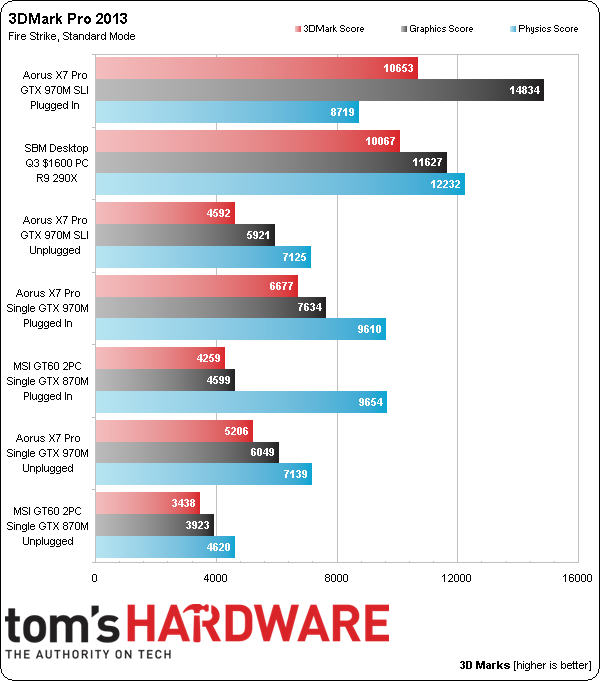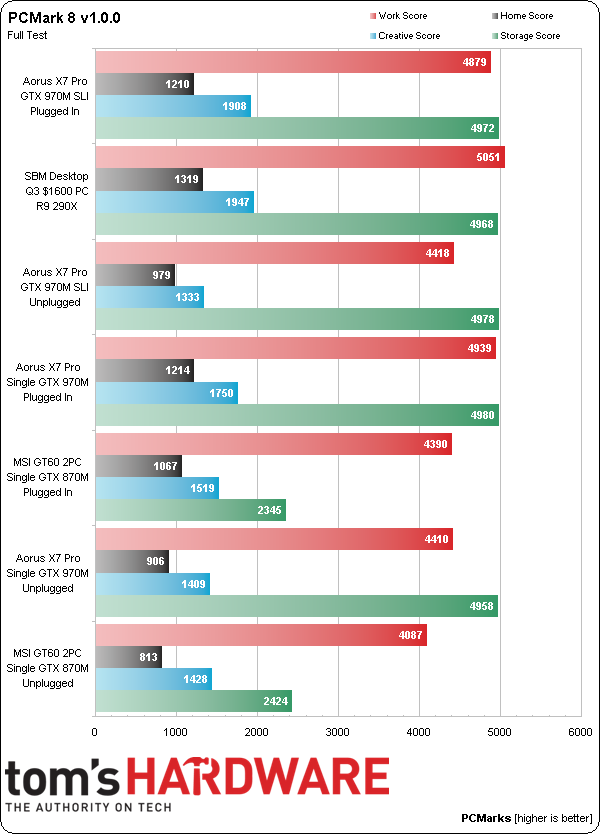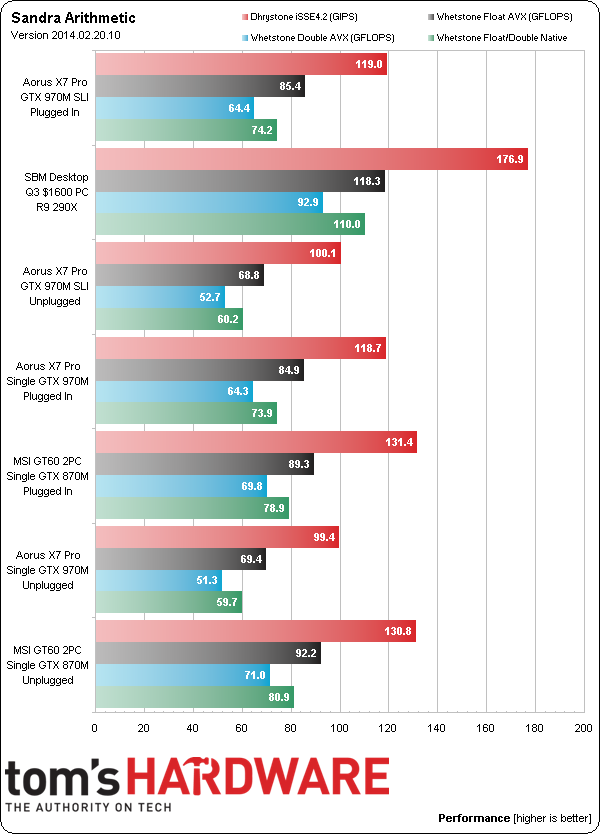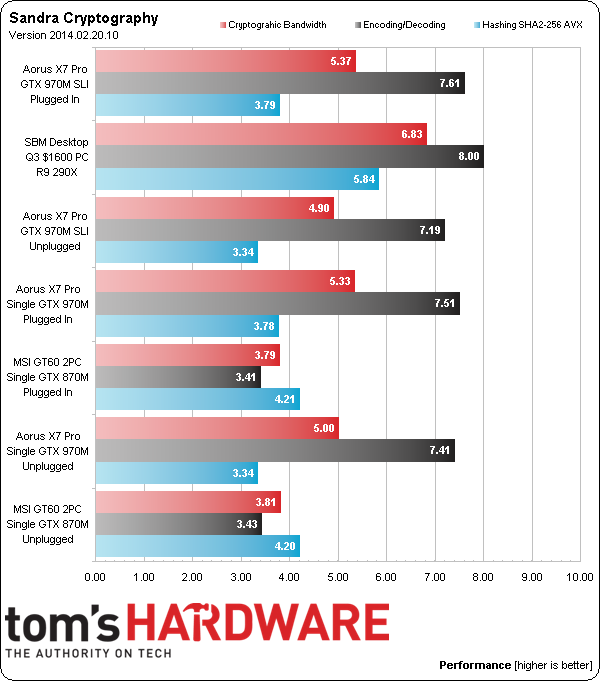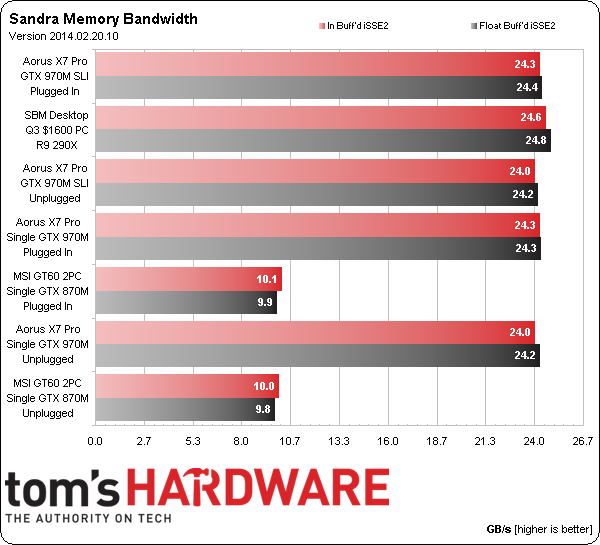Aorus X7 Pro Notebook Review: GeForce GTX 970M Gets Slim In SLI
Combining the power of two GeForce GTX 970M GPU in a compact chassis, Aorus enables the mobile market with incredible graphics potential. Can its X7 Pro really live up to the firm’s claims of desktop-class performance?
Results: 3DMark, PCMark And Sandra
3DMark
Aorus wanted its two mobile GPUs to go head-to-head against a single desktop GPU, and I’m happy to oblige. Its GTX 970Ms outpace my SBM build’s single Radeon R9 290X quite handily, though the mobile CPU has a hard time keeping up with the big machine’s full-speed version.
PCMark
A pair of mSATA SSDs in RAID 0 help the Aorus X7 Pro roughly match my SBM desktop build in PCMark, though my faster CPU boosts productivity performance. In the same manner, the MSI machine’s similar CPU performance results in only a slight loss in PCMark’s “Work” test, where its use of a mechanical disk accounts for that small deficiency.
Sandra
Sandra's Arithmetic module shows that the Aorus X7 Pro’s new CPU is slightly slower than the MSI GT60’s older processor. These two models employ the same core technology and peak Turbo Boost setting, but MSI’s socketed processor has a higher base clock rate than Aorus’s soldered-on CPU.
MSI’s platform loses against the Aorus X7 Pro in Sandra's Cryptography test for reasons that aren’t immediately apparent. A quick scroll to the next chart reveals that memory bandwidth is the cause for this quirk, which makes sense given AES-NI's reliance on fast data transfer to feed instructions quickly.
The most astonishing aspect of MSI’s GT60 isn’t the great hardware choices or low price the firm was offering on this product last spring, but rather that the company would sabotage its own performance story by installing just one memory module on a dual-channel architecture. That mismatch forced us to recommend that you only buy the machine from sellers able to upgrade the memory subsystem.
Get Tom's Hardware's best news and in-depth reviews, straight to your inbox.
Current page: Results: 3DMark, PCMark And Sandra
Prev Page How We Tested The Aorus X7 Pro Next Page Results: Arma 3 And Battlefield 4-
Nuckles_56 A nice machine but I wouldn't consider buying one til Nvidia fixes up the issues that the machine is having with SLIReply -
blackmagnum Boo SLI. You create more miserly than happiness. Do yourself a favor and buy a top single-gpu gaming notebook instead.Reply -
StarBound I'm assuming the screen is a 60hz making the SLI somewhat pointless. Still the machine is impressive but at the end of the day I cannot see myself getting something that lasts only 40min when performing its primary function (in this case gaming).Reply -
Steveymoo Colour me impressed. This could be the first truly functional gaming desktop replacement! It's faster than my desktop, and my GPU is less than a year old. Wowzers. And such a slim package.Reply -
AndrewBrodie Does the HDMI Port support HDMI 2.0? I would like to use it with a 4K TV and hope to exceed 30 FPS.Reply -
xyster FYI: Nvidia GeForce GTX 980M is offered also in 8GB capacities; not just 4gb. ie: MSI Dominator versions have it.Reply -
npyrhone The performance figures are really impressive, but why on earth are the "idle" and "reading" power consumption levels so absurdly high?Reply
I mean, I can somehow even understand the zombie drain by the other gpu, but even so: how is it possible that if you just write a word document and read news from the internet, you get something like 2h of battery life.
Obviously, the person who purchases this might not need even 1h battery life ever, but that does not change the fact that something seems to be wrong here, or even broken, when the previous gen laptop achieves 5-6h of battery life in such scenarios.
I am like 95% sure that either the power saving options were not enabled, or they were not functioning properly or some component was flawed or some driver was misbehaving. Or then something else weird was going on.
In any case, I am 100% certain that I can get 3-4h of battery life in a light use, non-gaming scenario with a properly built laptop even if it was sporting this kind of hardware (ie. i7-4870HQ, 970M SLI, 17,3" FHD...)
-
sportfreak23 Was thinking of purchasing this to replace my current Sony Vaio S as the dual core is starting to show its age. But the 1080p screen is kinda turn off when aorus offers a high res screen on its X3. Wish they made a high res 980M sli option to be purchased as this current 970m setup doesn't impress me much.Reply -
hst101rox On page 4, it is not just the Aorus x7 pro that has an AC adapter with an efficiency rating of "V", but the Delta 180W of the MSI GT60/70 and most any other new laptop, and tablet/smart phone charger should also be at that efficiency rating.Reply
